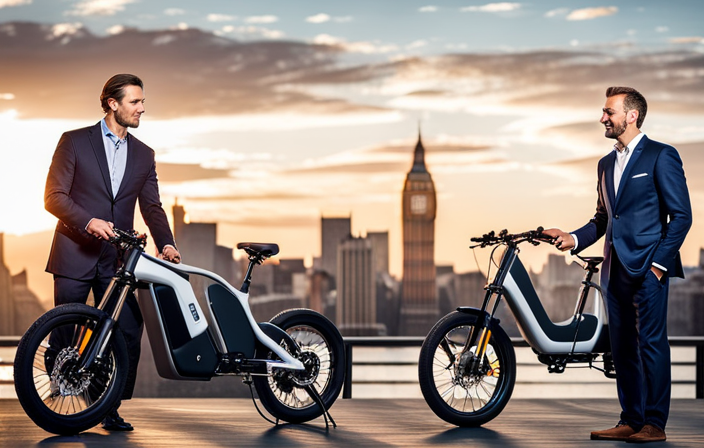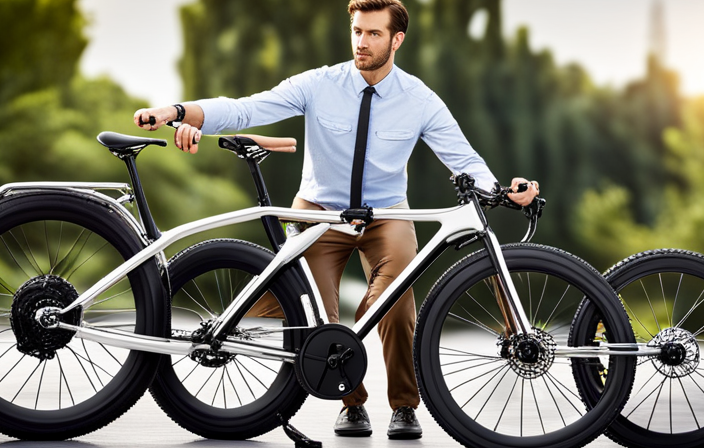An e-cargo bike can often replace a second car for daily errands and short trips, saving you thousands annually. With costs between $2,000 and $5,000, they’re cheaper upfront and have lower maintenance and fuel expenses. Plus, they help reduce environmental impact and traffic issues. While there are some practical limits, many find the savings and convenience well worth it. To see how much you could save and whether it fits your lifestyle, keep exploring the details.
Key Takeaways
- E-cargo bikes cost $2,000–$5,000, significantly less than second cars, reducing initial investment and ongoing expenses.
- Maintenance costs for e-cargo bikes are lower, with longer lifespans and fewer repairs compared to second vehicles.
- Energy and fuel savings from e-cargo bikes are substantial, decreasing operational costs over time.
- E-cargo bikes are ideal for short to moderate trips, replacing many errands and reducing the need for a second car.
- Long-term savings on insurance, repairs, and environmental benefits make e-cargo bikes a cost-effective alternative.
Initial Investment and Purchase Costs

When considering an e-cargo bike or a second car, the initial investment can be a significant factor. E-cargo bikes generally cost less upfront, often ranging from $2,000 to $5,000, depending on features like cargo capacity and storage options. They offer practical cargo capacity, with sturdy racks and compartments designed for groceries, packages, or even small furniture. In contrast, a second car can cost anywhere from $15,000 to over $30,000, covering purchase price, taxes, and registration. While the initial expense is higher for a car, it provides greater storage options and more room for larger items or multiple passengers. Your choice depends on your budget and your specific needs for cargo capacity and storage, balancing cost with transportation needs and urban mobility] considerations.
Maintenance and Operating Expenses

Maintenance and operating expenses for an e-cargo bike are generally lower than those for a second car. You’ll spend less on repairs, as e-cargo bikes have fewer moving parts and require less frequent maintenance. The battery lifespan is a key factor; batteries typically last several years before needing replacement, which is more affordable than a car engine overhaul. Plus, the cargo capacity of an e-cargo bike means you can handle most daily errands without extra costs for fuel or public transit. Additionally, cost-effective maintenance makes e-cargo bikes a practical alternative for many users. Moreover, vehicle longevity often exceeds that of traditional vehicles due to simpler mechanical systems. Staying informed about AI safety measures can help ensure the development of reliable and secure transportation options like e-cargo bikes. Furthermore, regular maintenance checks can extend the overall lifespan of your e-cargo bike, maximizing its cost benefits.
Fuel and Energy Savings

Switching to an e-cargo bike can substantially cut your energy and fuel costs compared to driving a second car. Unlike traditional bikes, an e-cargo bike offers impressive cargo capacity, allowing you to haul groceries, packages, or even small furniture without needing fuel. Its storage options are versatile, with front and rear racks or cargo boxes that keep your items secure and organized. Since e-cargo bikes run on electricity, you save markedly on fuel expenses, especially with rising fuel prices. Charging the bike is inexpensive, and it consumes far less energy than a car engine. Plus, you avoid idle time and traffic jams, further reducing energy use. Additionally, the integration of neural networks in smart e-bike systems can optimize routes and energy consumption for even greater efficiency. This technological advancement enhances energy optimization, making e-cargo bikes an even more efficient alternative. Moreover, the popularity of no-sugar-added beverages reflects a growing consumer interest in sustainable and health-conscious transportation options. Overall, an e-cargo bike provides a cost-effective, energy-efficient alternative for everyday transport and errands.
Usage Patterns and Practicality

Using an e-cargo bike in your daily routine can be highly practical, especially for short to moderate distances. Its cargo capacity allows you to carry groceries, kids, or work equipment without relying on a car. Storage options, such as racks or containers, enhance convenience, making quick errands or school runs easier. The bike’s versatility suits urban environments, where parking and traffic are challenges. You can easily maneuver bike lanes and avoid congestion, saving time. Additionally, the navigation tools on e-cargo bikes, such as GPS devices or smartphone apps, can help plan efficient routes. Incorporating safe riding practices is essential to ensure safety when navigating busy city streets. Furthermore, considering the performance of the bike, like motor power and battery range, can influence its suitability for your needs. The importance of regular maintenance cannot be overstated in ensuring optimal performance and longevity of your e-cargo bike. However, consider the bike’s cargo capacity limitations for larger loads or longer trips. Also, think about weather conditions and storage space at home or work. Overall, an e-cargo bike offers a flexible, efficient alternative for many daily tasks, but practicality depends on your specific needs and load requirements.
Environmental and Additional Benefits

Have you considered how an e-cargo bike can benefit the environment beyond just reducing car use? By improving urban mobility, it helps decrease traffic congestion and lowers air pollution in your city. Its cargo capacity allows you to transport groceries, packages, or even small appliances without relying on a car, further cutting emissions. E-cargo bikes produce no tailpipe emissions, making them a cleaner alternative that promotes healthier air quality. They also encourage more active transportation, supporting your physical health. Additionally, choosing an e-cargo bike over a second car reduces noise pollution and minimizes your carbon footprint. Developing a mindset & confidence about sustainable choices can motivate ongoing environmentally friendly habits. Overall, it’s a practical step toward more sustainable living and a greener urban environment.
Long-Term Financial Impact

Switching to an e-cargo bike or dropping your second car can substantially cut your long-term costs. You’ll spend less on maintenance, repairs, fuel, and insurance over time. Considering these savings helps you see the true financial impact of your transportation choices. Additionally, evaluating your trust issues can help you make more informed decisions about shared or alternative transportation options. Incorporating affairs – cheating husband secrets into your awareness can also assist in recognizing hidden risks in personal relationships, which may influence your overall well-being and decision-making. Incorporating hydrocolloid technology into your skincare routine can also enhance the healing process, especially when using effective acne patches.
Maintenance and Repair Costs
Although e-cargo bikes generally have lower maintenance costs than traditional vehicles, you should still budget for regular upkeep to keep them running smoothly over time. Proper maintenance helps preserve cargo capacity and ensures your storage solutions stay effective. Expect to check the brakes, tires, and battery periodically, as these are key components that affect performance and safety. Additionally, routine cleaning prevents dirt buildup that could impact cargo capacity and overall function. Maintenance costs are typically lower than a second car but can add up if neglected. Consider investing in durable storage solutions that protect your cargo and extend the bike’s lifespan. Regular tune-ups and timely repairs will help you avoid costly fixes and keep your e-cargo bike reliable for years. Also, battery health is crucial for optimal performance and longevity of your e-cargo bike’s electrical components, especially as performance tuning can help improve battery efficiency and lifespan. Moreover, staying informed about maintenance best practices can further reduce unexpected expenses and enhance your riding experience. Maintaining proper vital components consistently ensures safety and reliability in the long run.
Fuel and Insurance Savings
Ever wondered how much money you can save on fuel and insurance by choosing an e-cargo bike over a second car? With an e-cargo bike, you eliminate fuel costs entirely, since pedaling or using electric assist is far cheaper than gas. Insurance premiums are also notably lower, as bikes typically don’t require comprehensive coverage like cars do. Plus, the cargo capacity and storage solutions of an e-cargo bike make hauling groceries or gear easy without extra costs. This means fewer trips in a second car, further reducing fuel use and insurance needs. Additionally, modern wall organization systems promote water efficiency, which can decrease water bills associated with vehicle maintenance or household water use. Incorporating eco-friendly urban transportation options can also contribute to long-term savings and environmental benefits. Over time, these savings add up, making an e-cargo bike a more economical choice for daily errands and short commutes, all while offering practical cargo capacity for your lifestyle.
Conclusion
Ultimately, switching to an e-cargo bike is like planting a seed that blossoms into savings and sustainability. While the initial costs might seem steep, the ongoing savings and environmental benefits grow steadily over time, making your wallet and the planet healthier. If your daily routes are manageable, this bike could be your loyal steed, turning your commute into a greener, more economical journey—proof that small changes can create a ripple effect of positive change.









